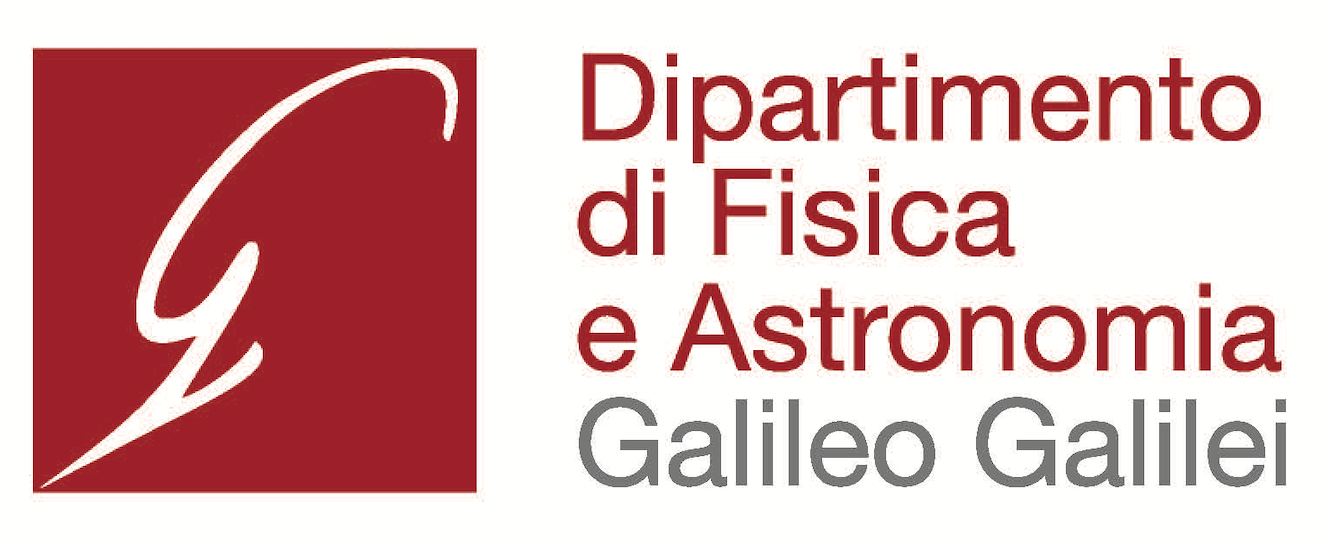Dark Matter Studies in Accelerator Physics
Sala Livio Paladin, Palazzo Moroni
Padova




DMNet International Symposium
The JSPS Core-to-Core Program “International Research Network to Reveal Dark Matter in the Universe by Multidisciplinary Approach in Particle and Astrophysics” (DMNet) started in 2020.
The 3rd DMNet international symposium is organized by the INFN-Padova Unit and the Department of Physics and Astronomy "Galileo Galilei"of the Padova University, it will be held at Palazzo Moroni, Padova, Italy from September 26th to 28th, 2023.

The topics in the 3rd DMNet international symposium are dark matter studies in accelerator physics. In the 2nd DMNet international symposium, we focused on the direct and indirect detection of dark matter. The direct production of dark matter particles with accelerators is a method to reveal the nature of dark matter, complemental to the direct and indirect detection of dark matter. It might be ultimate since we may reveal the underlying particle physics model with accelerators in addition to the nature of dark matter.
The following topics we will focus of this symposium:
- Latest dark matter and BSM searches at the LHC and the Belle-II
- Prospects of dark matter and BSM searches in future experiments with accelerators including fixed target experiments
- Particle physics models of dark matter
- Latest results of direct and indirect detection of dark matter, complemental to the accelerator physics, and the impact on the dark matter models
-
-
10:30
→
12:00
Closed session: DMnet internal assembly 1h 30m Sala Livio Paladin, Palazzo Moroni
Sala Livio Paladin, Palazzo Moroni
Padova
Via del Municipio, 1, 35122 Padova PD -
12:00
→
13:30
Lunch break 1h 30m Padova downtown
Padova downtown
-
13:30
→
14:00
Registration 30m Sala Livio Paladin, Palazzo Moroni
Sala Livio Paladin, Palazzo Moroni
Padova
Via del Municipio, 1, 35122 Padova PD -
14:00
→
14:10
Opening and Welcome 10m Sala Livio Paladin, Palazzo Moroni
Sala Livio Paladin, Palazzo Moroni
Padova
Via del Municipio, 1, 35122 Padova PDWelcom message from the Head of the Department of Physics and Astrophysics of the Padua University
Speaker: Flavio Seno (dipartimento di fisica e astronomia "g. galilei" - Universitá di Padova) -
14:10
→
14:50
Introduction of Dark Matter 40m Sala Livio Paladin, Palazzo Moroni
Sala Livio Paladin, Palazzo Moroni
Padova
Via del Municipio, 1, 35122 Padova PDSpeaker: Takeo Moroi (Tokyo) -
14:50
→
15:30
Overview of direct DM detection 40m Sala Livio Paladin, Palazzo Moroni
Sala Livio Paladin, Palazzo Moroni
Padova
Via del Municipio, 1, 35122 Padova PDSpeaker: Yoshitaka Itow (STEL/KMI Nagoya University) -
15:30
→
16:50
Poster session Sala Livio Paladin, Palazzo Moroni
Sala Livio Paladin, Palazzo Moroni
Padova
Via del Municipio, 1, 35122 Padova PD-
15:30
Novel loop-diagrammatic approach to QCD θ parameter and application to the left-right model 20m
When the QCD axion is absent in full theory, the strong CP problem has to
be explained by an additional mechanism, e.g., the left-right symmetry. Even though tree-
level QCD θ ̄ parameter is restricted by the mechanism, radiative corrections to θ ̄ are mostly
generated, which leads to a dangerous neutron electric dipole moment (EDM). The ordinary
method for calculating the radiative θ ̄ utilizes an equation θ ̄ = −arg det mloop based on the q
chiral rotations of complex quark masses. In this paper, we point out that when full theory includes extra heavy quarks, the ordinary method is unsettled for the extra quark contributions and does not contain its full radiative corrections. We formulate a novel method to calculate the radiative corrections to θ ̄ through a direct loop-diagrammatic approach, which should be more robust than the ordinary one. As an application, we investigate the radiative θ ̄ in the minimal left-right symmetric model. We first confirm a seminal result that two-loop level radiative θ ̄ completely vanishes (corresponding to one- loop corrections to the quark mass matrices). Furthermore, we estimate the size of a non- vanishing radiative θ ̄ at three-loop level. It is found that the resultant induced neutron EDM is comparable to the current experimental bound, and the expected size is restricted by the perturbative unitarity bound in the minimal left-right model.Speaker: Naohiro Osamura (Nagoya)
-
15:30
-
16:50
→
17:20
Cofee break 30m Sala Livio Paladin, Palazzo Moroni
Sala Livio Paladin, Palazzo Moroni
Padova
Via del Municipio, 1, 35122 Padova PD -
17:20
→
18:00
Cosmological overview 40m Sala Livio Paladin, Palazzo Moroni
Sala Livio Paladin, Palazzo Moroni
Padova
Via del Municipio, 1, 35122 Padova PDSpeaker: Vivian Poulin (LUPM) -
18:00
→
19:30
Visit Padova downtown 1h 30m Sala Livio Paladin, Palazzo Moroni
Sala Livio Paladin, Palazzo Moroni
Padova
Via del Municipio, 1, 35122 Padova PD -
19:50
→
20:50
Welcome party 1h Caffe Pedrocchi
Caffe Pedrocchi
Padova
Via VIII Febbraio 15
-
10:30
→
12:00
-
-
09:00
→
09:30
Higgsino / Wino search 30m Sala Livio Paladin, Palazzo Moroni
Sala Livio Paladin, Palazzo Moroni
Padova
Via del Municipio, 1, 35122 Padova PDSpeaker: Satoshi Shirai -
09:30
→
10:00
Muon g-2 in MSSM 30m Sala Livio Paladin, Palazzo Moroni
Sala Livio Paladin, Palazzo Moroni
Padova
Via del Municipio, 1, 35122 Padova PDSpeaker: Teppei Kitahara (Karlsruhe Institute of Technology) -
10:00
→
10:30
Sub-GeV DM @ beam damp 30m Sala Livio Paladin, Palazzo Moroni
Sala Livio Paladin, Palazzo Moroni
Padova
Via del Municipio, 1, 35122 Padova PDSpeaker: Daiki Ueda -
10:30
→
10:50
Coffee Break 20m Sala Livio Paladin, Palazzo Moroni
Sala Livio Paladin, Palazzo Moroni
Padova
Via del Municipio, 1, 35122 Padova PD -
10:50
→
11:20
Dark matter and flavor 30m Sala Livio Paladin, Palazzo Moroni
Sala Livio Paladin, Palazzo Moroni
Padova
Via del Municipio, 1, 35122 Padova PDSpeaker: Diego Redigolo (Istituto Nazionale di Fisica Nucleare) -
11:20
→
11:50
Light Dark Sectors (dark photon EFT, hidden valley) 30m Sala Livio Paladin, Palazzo Moroni
Sala Livio Paladin, Palazzo Moroni
Padova
Via del Municipio, 1, 35122 Padova PDSpeaker: Giovanni Grilli Di Cortona (Istituto Nazionale di Fisica Nucleare) -
11:50
→
12:20
Non-standard dark matter freeze-out 30m Sala Livio Paladin, Palazzo Moroni
Sala Livio Paladin, Palazzo Moroni
Padova
Via del Municipio, 1, 35122 Padova PDSpeaker: andrzej hryczuk (National Centre for Nuclear Research, Poland) -
12:20
→
14:00
Lunch break 1h 40m Padova downtown
Padova downtown
-
14:00
→
14:40
Overview indirect detection 40m Sala Livio Paladin, Palazzo Moroni
Sala Livio Paladin, Palazzo Moroni
Padova
Via del Municipio, 1, 35122 Padova PDSpeaker: Michele Doro (University of Padova) -
14:40
→
15:20
Overview g-2 results 40m Sala Livio Paladin, Palazzo Moroni
Sala Livio Paladin, Palazzo Moroni
Padova
Via del Municipio, 1, 35122 Padova PDSpeaker: Anna Driutti -
15:20
→
15:50
Coffee break 30m Sala Livio Paladin, Palazzo Moroni
Sala Livio Paladin, Palazzo Moroni
Padova
Via del Municipio, 1, 35122 Padova PD -
15:50
→
16:30
Transfer to Giovanni Poleni museum 40m
-
16:30
→
17:30
Visit Giovanni Poleni Museum 1h Giovanni Poleni Museum
Giovanni Poleni Museum
Via Loredan 10, Padova
-
09:00
→
09:30
-
-
09:00
→
09:30
New directions of BSM searches at HL-LHC 30m Sala Livio Paladin, Palazzo Moroni
Sala Livio Paladin, Palazzo Moroni
Padova
Via del Municipio, 1, 35122 Padova PDSpeaker: Caterina Doglioni (Universite de Geneve) -
09:30
→
10:00
Dark matter and low multiplicity seaches at Belle II 30m Sala Livio Paladin, Palazzo Moroni
Sala Livio Paladin, Palazzo Moroni
Padova
Via del Municipio, 1, 35122 Padova PDSpeaker: Enrico Graziani (Istituto Nazionale di Fisica Nucleare) -
10:00
→
10:20
Belle II DM specific analysis 1 20m Sala Livio Paladin, Palazzo Moroni
Sala Livio Paladin, Palazzo Moroni
Padova
Via del Municipio, 1, 35122 Padova PDSpeaker: Laura Zani (Istituto Nazionale di Fisica Nucleare) -
10:20
→
10:50
BSM and DM result summary at LHC 30m Sala Livio Paladin, Palazzo Moroni
Sala Livio Paladin, Palazzo Moroni
Padova
Via del Municipio, 1, 35122 Padova PDSpeaker: Javier Montejo Berlingen (IFAE) -
10:50
→
11:10
Coffee break 20m Sala Livio Paladin, Palazzo Moroni
Sala Livio Paladin, Palazzo Moroni
Padova
Via del Municipio, 1, 35122 Padova PD -
11:10
→
11:40
FASER experiment in general + Future Forward Facility 30m Sala Livio Paladin, Palazzo Moroni
Sala Livio Paladin, Palazzo Moroni
Padova
Via del Municipio, 1, 35122 Padova PDSpeaker: Akitaka Ariga (University of Bern) -
11:40
→
12:05
EW SUSY searches 25m Sala Livio Paladin, Palazzo Moroni
Sala Livio Paladin, Palazzo Moroni
Padova
Via del Municipio, 1, 35122 Padova PDSpeaker: Yuya Mino (Kyoto University) -
12:05
→
12:30
Anomaly detection for BSM searches 25m Sala Livio Paladin, Palazzo Moroni
Sala Livio Paladin, Palazzo Moroni
Padova
Via del Municipio, 1, 35122 Padova PDSpeaker: Jennifer Curran (University Edinburgh) -
12:30
→
14:00
Lunch break 1h 30m Padova downtown
Padova downtown
-
14:00
→
14:25
Future circular collider (FCC) physics prospects 25m Sala Livio Paladin, Palazzo Moroni
Sala Livio Paladin, Palazzo Moroni
Padova
Via del Municipio, 1, 35122 Padova PDSpeaker: Patrizia Azzi (Istituto Nazionale di Fisica Nucleare) -
14:25
→
14:50
Future muon collider (MUCOL) physics prospects 25m Sala Livio Paladin, Palazzo Moroni
Sala Livio Paladin, Palazzo Moroni
Padova
Via del Municipio, 1, 35122 Padova PDSpeaker: Donatella Lucchesi (Istituto Nazionale di Fisica Nucleare) -
14:50
→
15:20
BSM & DM result summary in LHCb 30m Sala Livio Paladin, Palazzo Moroni
Sala Livio Paladin, Palazzo Moroni
Padova
Via del Municipio, 1, 35122 Padova PDSpeaker: Federico Leo Redi (CERN) -
15:20
→
15:40
Cofee break 20m Sala Livio Paladin, Palazzo Moroni
Sala Livio Paladin, Palazzo Moroni
Padova
Via del Municipio, 1, 35122 Padova PD -
15:40
→
16:10
Belle II physics results 30m Sala Livio Paladin, Palazzo Moroni
Sala Livio Paladin, Palazzo Moroni
Padova
Via del Municipio, 1, 35122 Padova PDSpeaker: Steven Robertson (IPP/McGill University) -
16:10
→
16:30
Dark matter search at Belle 20m Sala Livio Paladin, Palazzo Moroni
Sala Livio Paladin, Palazzo Moroni
Padova
Via del Municipio, 1, 35122 Padova PDSpeaker: Thomas Czank (Tokyo Metropolitan University) -
16:30
→
17:00
PADME physics results 30m Sala Livio Paladin, Palazzo Moroni
Sala Livio Paladin, Palazzo Moroni
Padova
Via del Municipio, 1, 35122 Padova PDSpeaker: Mauro Raggi (Istituto Nazionale di Fisica Nucleare) -
17:00
→
17:20
Belle II DM specific analysis 2 20m Sala Livio Paladin, Palazzo Moroni
Sala Livio Paladin, Palazzo Moroni
Padova
Via del Municipio, 1, 35122 Padova PDSpeaker: Martina Laurenza -
17:20
→
17:30
Closing remarks 10m Sala Livio Paladin, Palazzo Moroni
Sala Livio Paladin, Palazzo Moroni
Padova
Via del Municipio, 1, 35122 Padova PDSpeaker: Junji Hisano (KMI, Nagoya Univ.)
-
09:00
→
09:30
